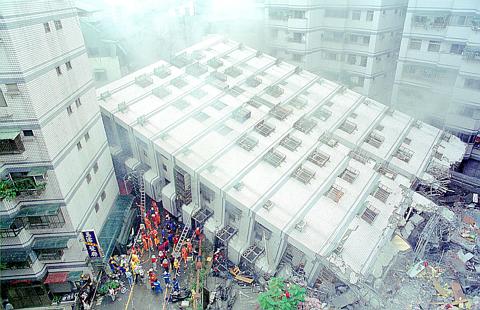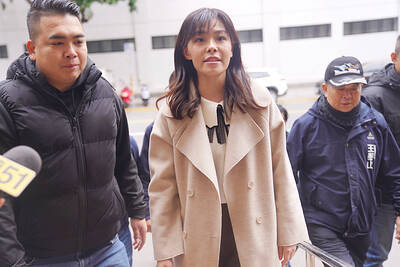As the international community poured out condolences and sent rescue workers to Taiwan last night to join the desperate search for survivors of yesterday's earthquake, the nation continued to count the loss in life and property caused by its biggest temblor this century.
By midnight yesterday, a total of 1,712 people were reported killed, 4,005 injured, 219 missing and 2,991 trapped inside buildings, according to the Ministry of the Interior's disaster management center. About 30,000 houses were damaged or destroyed.
Meanwhile the first foreign group of rescue workers, comprising 71 professionals and six government officials, arrived from Japan, the Ministry of Foreign Affairs said.

PHOTO: CHEN CHENG-CHANG, TAIPEI TIMES
Chinese President Jiang Zemin extended condolences and offered aid to the quake victims, even though the disaster occurred at a time of tense relations between China and Taiwan.
Thanks were expressed in Taiwan, with Su Chi (
President Lee Teng-hui (

PHOTO: GEORGE TSORNG, TAIPEI TIMES
Legislative Speaker Wang Jyn-ping (
Minister of Finance Paul Chiu (
The quake struck at 1:47am yesterday morning, 12.5km west of Sun Moon Lake (
Since the main earthquake, the island has been struck by at least 36 major aftershocks among a total of 600 aftershocks of various strengths.
The quake caused power outages almost islandwide, though as of press time Taipower said electricity had been restored to 59 percent of the island.
Damage was sustained across nearly the entire island, mostly from Chiayi in the south to Taipei in the north, but the majority was sustained in Nantou and Taichung, near the epicenter, where hundreds of buildings -- many recently built -- were flattened.
In Taichung County alone, the death toll had reached 816 by press time and was expected to climb further along with the rescue work.
Several towns in central Taiwan were cut off as night fell with thousands of people still unaccounted for.
Centering on the small town of Puli, an area with a radius of at least 30 kilometers was still unreachable by rescuers except by helicopter.
As night fell, the few crews flying into the heart of the disaster zone were forced to suspend drops of medicine and food and airlifts of the injured as a cut in all supply of power to the hilly area had made flying too dangerous.
With communications and land transport broken, word of conditions inside the eye of the catastrophe, normally a honeymoon haven and center for culture and the arts, was scant.
At Nantou, the number of bodies ferried by helicopter to waiting ambulances from Puli and surrounding areas painted a cataclysmic picture.
The corpses quickly swamped hospital morgues and staff began laying the dead by the roadside taped up in blue plastic sheets. Power shortages meant even those bodies in morgues soon began to decay in the 27 degree heat.
Frantic survivors tried to peer through the colored wrapping as they searched for missing family members. Ambulances rushed past in a constant file, ferrying fresh victims.
At the end of a line of bodies, a family gathered around one corpse and rocked back and forth on their knees, murmuring Taoist prayers over offerings of ghost money for the dead to take with them.
Work was impeded by a lack of supplies and replacements for weary rescue teams as the night wore on.
Travelling with a 30-member team from the Buddhist Compassion Relief Tzu Chi Association, on a rescue mission with a small group of doctors, a Taipei Times reporter witnessed attempts to pull victims from a damaged building in the Nantou town of Tunghsi.
But the work was hampered by a lack of heavy machinery, as well as continuing aftershocks that made working in the wreckage very dangerous.
One injured man said the earthquake had caught him by surprise, having been woken from slumber in a traditional farm house -- a "si he yuan (
Lin Yun-feng (
In the town, virtually every building appeared to have suffered some structural damage.
Taiwan's leading seismologists had been predicting for some time that a large-scale earthquake was imminent. So one might expect members of their scientific community to be relieved, in a way, that it has finally arrived. But they aren't. The reason? This was not the earthquake they had been expecting. Which means that their original predictions stand: Taiwan is still, according to past records, scheduled for another

The US government has signed defense cooperation agreements with Japan and the Philippines to boost the deterrence capabilities of countries in the first island chain, a report by the National Security Bureau (NSB) showed. The main countries on the first island chain include the two nations and Taiwan. The bureau is to present the report at a meeting of the legislature’s Foreign Affairs and National Defense Committee tomorrow. The US military has deployed Typhon missile systems to Japan’s Yamaguchi Prefecture and Zambales province in the Philippines during their joint military exercises. It has also installed NMESIS anti-ship systems in Japan’s Okinawa

‘WIN-WIN’: The Philippines, and central and eastern European countries are important potential drone cooperation partners, Minister of Foreign Affairs Lin Chia-lung said Minister of Foreign Affairs Lin Chia-lung (林佳龍) in an interview published yesterday confirmed that there are joint ventures between Taiwan and Poland in the drone industry. Lin made the remark in an exclusive interview with the Chinese-language Liberty Times (the Taipei Times’ sister paper). The government-backed Taiwan Excellence Drone International Business Opportunities Alliance and the Polish Chamber of Unmanned Systems on Wednesday last week signed a memorandum of understanding in Poland to develop a “non-China” supply chain for drones and work together on key technologies. Asked if Taiwan prioritized Poland among central and eastern European countries in drone collaboration, Lin

BACK TO WORK? Prosecutors said they are considering filing an appeal, while the Hsinchu City Government said it has applied for Ann Kao’s reinstatement as mayor The High Court yesterday found suspended Hsinchu mayor Ann Kao (高虹安) not guilty of embezzling assistant fees, reducing her sentence to six months in prison commutable to a fine from seven years and four months. The verdict acquitted Kao of the corruption charge, but found her guilty of causing a public official to commit document forgery. The High Prosecutors’ Office said it is reviewing the ruling and considering whether to file an appeal. The Taipei District Court in July last year sentenced Kao to seven years and four months in prison, along with a four-year deprivation of civil rights, for contravening the Anti-Corruption

NO CONFIDENCE MOTION? The premier said that being toppled by the legislature for defending the Constitution would be a democratic badge of honor for him Premier Cho Jung-tai (卓榮泰) yesterday announced that the Cabinet would not countersign the amendments to the local revenue-sharing law passed by the Legislative Yuan last month. Cho said the decision not to countersign the amendments to the Act Governing the Allocation of Government Revenues and Expenditures (財政收支劃分法) was made in accordance with the Constitution. “The decision aims to safeguard our Constitution,” he said. The Constitution stipulates the president shall, in accordance with law, promulgate laws and issue mandates with the countersignature of the head of the Executive Yuan, or with the countersignatures of both the head of the Executive Yuan and ministers or